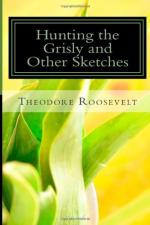In a few wild spots in the East, in northern Maine for instance, here and there in the neighborhood of the upper Great Lakes, in the east Tennessee and Kentucky mountains and the swamps of Florida and Mississippi, there still lingers an occasional representative of the old wilderness hunters. These men live in log-cabins in the wilderness. They do their hunting on foot, occasionally with the help of a single trailing dog. In Maine they are as apt to kill moose and caribou as bear and deer; but elsewhere the two last, with an occasional cougar or wolf, are the beasts of chase which they follow. Nowadays as these old hunters die there is no one to take their places, though there are still plenty of backwoods settlers in all of the regions named who do a great deal of hunting and trapping. Such an old hunter rarely makes his appearance at the settlements except to dispose of his peltry and hides in exchange for cartridges and provisions, and he leads a life of such lonely isolation as to insure his individual characteristics developing into peculiarities. Most of the wilder districts in the eastern States still preserve memories of some such old hunter who lived his long life alone, waging ceaseless warfare on the vanishing game, whose oddities, as well as his courage, hardihood, and woodcraft, are laughingly remembered by the older settlers, and who is usually best known as having killed the last wolf or bear or cougar ever seen in the locality.
Generally the weapon mainly relied on by these old hunters is the rifle; and occasionally some old hunter will be found even to this day who uses a muzzle loader, such as Kit Carson carried in the middle of the century. There are exceptions to this rule of the rifle however. In the years after the Civil War one of the many noted hunters of southwest Virginia and east Tennessee was Wilber Waters, sometimes called The Hunter of White Top. He often killed black bear with a knife and dogs. He spent all his life in hunting and was very successful, killing the last gang of wolves to be found in his neighborhood; and he slew innumerable bears, with no worse results to himself than an occasional bite or scratch.
In the southern States the planters living in the wilder regions have always been in the habit of following the black bear with horse and hound, many of them keeping regular packs of bear hounds. Such a pack includes not only pure-bred hounds, but also cross-bred animals, and some sharp, agile, hard-biting fierce dogs and terriers. They follow the bear and bring him to bay but do not try to kill him, although there are dogs of the big fighting breeds which can readily master a black bear if loosed at him three or four at a time; but the dogs of these southern bear-hound packs are not fitted for such work, and if they try to close with the bear he is certain to play havoc with them, disemboweling them with blows of his paws or seizing them in his arms and biting through their spines or legs. The riders follow the hounds through the canebrakes, and also try to make cutoffs and station themselves at open points where they think the bear will pass, so that they may get a shot at him. The weapons used are rifles, shotguns, and occasionally revolvers.




